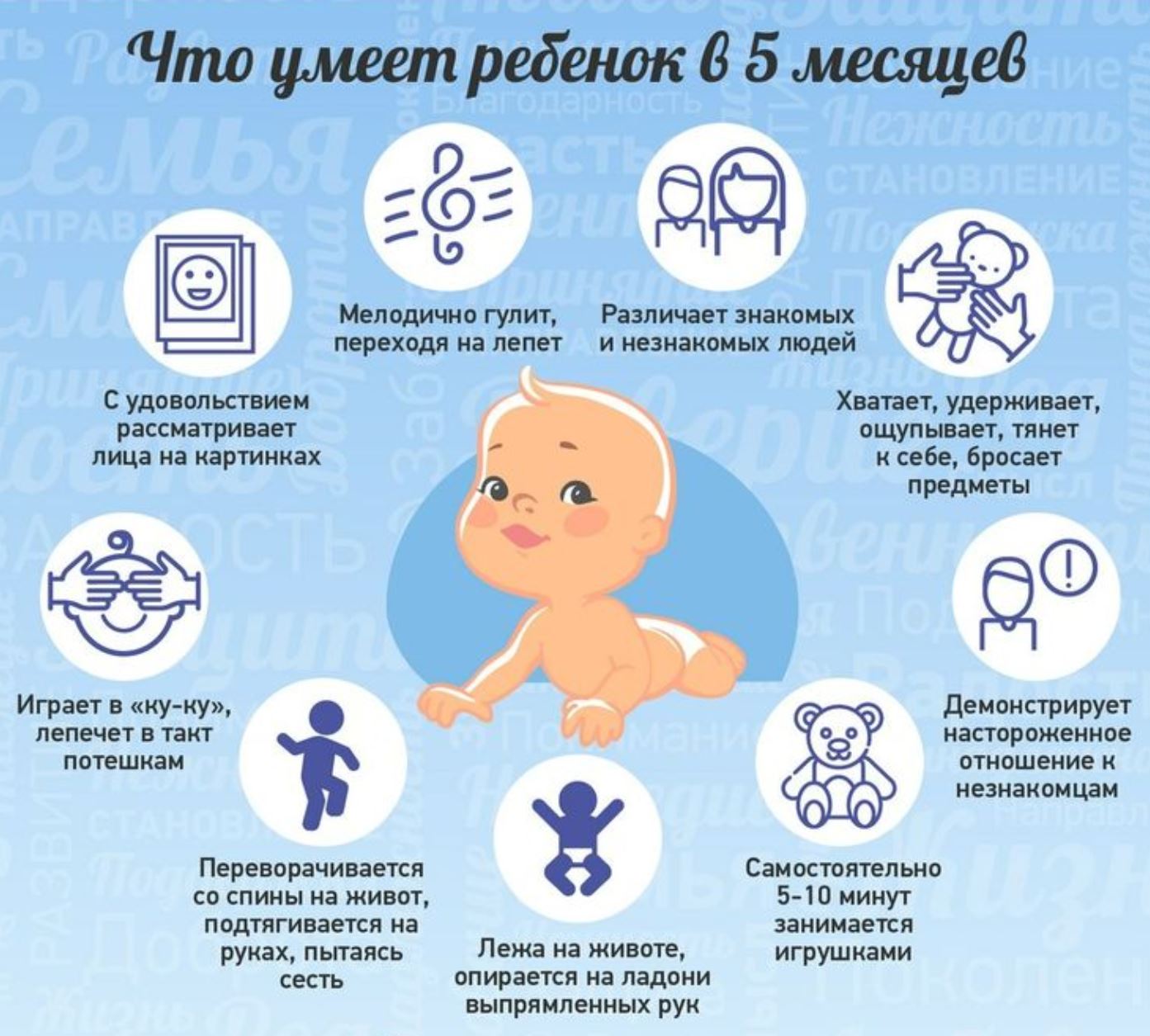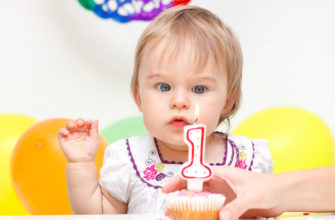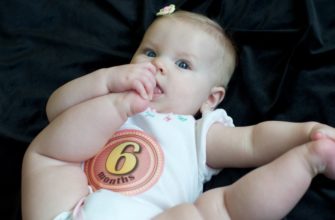Five months for a child is an age when mastering new skills and improving existing ones comes to the fore. By this age, children double in weight and finally turn into chubby pink-cheeked peanuts. Many babies in 5 months delight parents with the first tooth or its harbingers. The duration of active wakefulness during the day increases, which means that there is more time for communication with mom.

Five month skills
All these changes form a certain development background, on which new abilities and skills of the child are clearly distinguished. It’s about them that they’ll talk now.
- The ability to raise the head and shoulders above the surface is developing and improving. This position is taken by the kids lying on their tummy. If earlier the child rested on his forearms and could remain in this position for less than a minute, then at 5 months the child can lean on his hands and arms and hold the pose for a little longer. In a new perspective, the world is much more interesting for the baby, so for a five-month-old baby this pose can be called classic;
- The baby masters a new position: leans on straightened arms. At this age, vision is already very well developed, and from this position the child with pleasure looks around the whole room;
- The development of the crawling skill begins - in the supine position, the baby is trying to push its body forward. At five months, the most active babies are already crawl;
- Coordination of movements reaches a new level. The movements that the child makes with his hands are now perfectly coordinated by vision. A child can correctly pick up an object of interest, regardless of whether it is suspended above its head, or lies next to the right or left. Thanks to eye-hand coordination, the baby is able to extend the handle in the right direction and to the required distance;
- A significant leap is felt in the development of motor skills. For a long time to hold an object in hands, to feel it in every possible way, to take an object from the hands of an adult and to freely unclench a palm, press buttons - all this a child can do at 5 months. Also at this age, children begin to train the ability to shift an object from one hand to another. At this stage, the mother can help the baby a little in mastering new actions. A good effect is exerted by palm massage, flexion and extension of the fingers, and, of course, joint games with rattles and any other interesting objects: show, offer the child to take the toy in his hand;
- The child begins to be interested in his own body. Against the background of the development of “touching” skills, this interest is shown in feeling your own body and limbs. Many babies with real surprise discover that they have legs, they like to examine them, touch them, try to lick them or put them in their mouths. This is an absolutely natural, normal interest. It’s not worth stopping him, it’s better to use the moment to tell the child what the parts of the body are called, to show them on yourself, toys and the little one;
- Five months is the age of the rodent. Some babies already first tooth appearsbut if teething has not yet occurred, then there are certainly precursors to this miracle. Usually in the region of 5 months, many babies begin to salivate profusely, gums swell, and the baby does not only pull everything in his mouth to lick, but also begins to gnaw on toys and other objects. Moms can be recommended to give the baby a gum massage (either with clean fingers or a glove) and be sure to stock up on silicone toys-rodents. (Read about helping a baby during teething);
- Lure. Previously, the baby was able to receive only liquid food. Food of any other consistency was either pushed out by the tongue, or provoked a gag reflex, getting to the root of the tongue. At 5 months, the baby can already eat a homogeneous, not thick mashed potatoes. Many moms at this age start feeding, although if the baby is breastfeeding, it is better to offer complementary foods after 6 months according to WHO recommendations;
- In social terms, the child is already becoming a real communication partner and actively interacts with adults. The kid initiates and supports joint games. For example, throws toys, and mother raises and returns to the child. The well-known “cuckoo” game is very loved by the kids;
- It shows an increased interest in individuals: he watches with curiosity his mother’s facial expressions, feels her nose, grabs her hair, tries to touch her eyes (the faces of strangers or his own reflection in the mirror cause no less interest);
- Divides the world into "friends" and "strangers", well distinguishes familiar people from strangers (the latter is wary, but with interest), is ready to communicate with an unknown person only in the presence of his mother;
- The child begins to show the first signs of infant growth - babies starting from about 5 months of age already know how (and love!) To hold a bottle with a mixture or with water on their own;
- If you hold the baby by the arms, but he is able to stand on the legs for several seconds;
- Leg extension when resting on a hard surface. If mom puts the baby on the floor or any other hard surface, he will not bend his knees, but will straighten them completely, rising to his toes. The child will learn to fully rely on the foot in a couple of months;
- Lifting the body with support on the hands of an adult. This is the most important skill of a five month old baby. If you grab hold your hands to the lying child, he grabs them and tries to pull himself up. Such an exercise not only strengthens the muscular corset of the spine and abdominal muscles, but also trains one of the baby’s main skills - the ability to sit independently;
- Depending on the situation, it demonstrates a variety of emotions - joy, fear, resentment, curiosity;
- May spend more time alone with himself - Studying and licking toys with pleasure, own fingers and toes. Able to play independently for 5-10 minutes;
- Grasped by the handles of the bars of the crib and pulledtrying to crouch or take upright position;
- Children at 5 months are already able to roll over from back to stomach and back. As soon as they discover that they know how to do this, they begin to actively "work" with their legs - it is fun to shake them and take the pose of a "frog" as if they are going "to great swimming."
RememberAs soon as you find that your five-month-old baby is able to roll over, from that moment you can not leave him alone on the bed or on any other surface at any height. Alas, falling even from a height of 30-40 cm can cause serious harm to the baby.
We also read: 5 month baby development

Games
These simple games have deep psychological overtones. For example, returning a toy to a child reinforces his sense of constancy of the surrounding world: wherever a toy falls, it returns to its hands. Awareness of the stability of the world is the most important thing, it is with it that the formation of basic trust in the world begins and the feeling of reliable soil underfoot, without which harmonious personal development is impossible.
The game of "ku-ku" gives a lot for the relationship between mother and baby. The child has his own logic: if I am not visible, then I am not. It is very important for a child to feel that his mother thinks about him even when he is not in sight, looking for him. For the baby, this is a confirmation of mom's love.
Speech
Speech continues to evolve. The child actively pronounces syllables and new sounds, expanding the range of pronounced vowels and consonants. Combinations of different syllables form babble. Often babies repeatedly repeat the same syllables ("dy-dy-dya", "ba-ba-ba", "mama-ma-ma"). In these “words” there is still no awareness and meaning, but parents need to support and stimulate the speech activity of the crumbs. In addition to creating a rich speech environment, you can start classes on the development of fine motor skills. Indirectly, these activities also affect the development of speech.
Have a seat
Some boys can already sit on their own. However, weak spinal muscles are not always ready for such a load. It is necessary to ensure that there is always a pillow behind the baby's back. This is necessary so that he does not hit, sharply leaning back when tired. Girls, as a rule, do not sit down by five months; they are ready for this only after a month. Moreover, all children at this age, while holding hands, happily go into a sitting position.
Important! If the child has not yet been sitting on his own, he cannot be seated by force. The back muscles, spine and internal organs are not yet ready for sitting. Premature sitting is fraught with curvature of the spine and anomalies of the organs. This is especially true for girls whose reproductive system is extremely sensitive.
Acquaintance with a book
First of all - with pictures. The kid will be interested to see colorful images. Of particular interest in this regard are animals. At the same time, hearing the simple “mu”, “woof”, “meow” and “kar”, the baby will try to repeat these simple syllables, thereby adding to his vocabulary.
He enthusiastically examines faces in photographs and pictures.
Deviations in development: when to sound the alarm
- the baby’s speech consists only of humming (stretching vowels), while the child does not pronounce consonant sounds and does not try to put them into syllables;
- the child does not know how to roll over from the abdomen to the back and does not attempt to pull himself up when they hold out his hands;
- lack of interest in toys and surrounding objects.
These are the basic skills owned by about 90% of healthy children developing according to age. Do not worry if the baby is slightly behind peers: many factors, including heredity, affect the rate of development and growth. But if the deviations from the norm are significant, you should definitely show the child to a pediatrician, as this may be the result of hidden diseases of the nervous, endocrine and other major body systems.
- Last month: what a child can do at 4 months
- Next month: what a 6 month old baby can do
We also read: The regimen (schedule) of a child’s day at 5 months - sleep, feeding, walking, games and development
We also read: Baby development by month (calendar from 1-12 month) | skills of a child in 1 year
The child is 5 months old. What we can do








